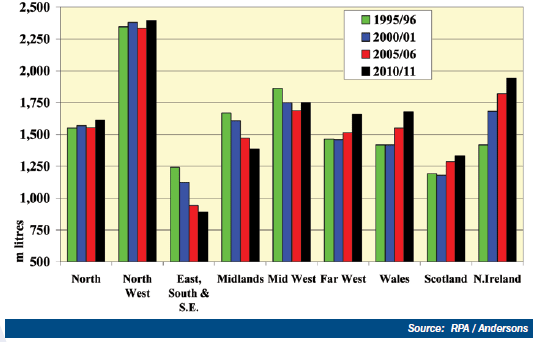



Andersons 2012 Dairy Outlook
The Andersons 2012 outlook studies the consequences of the past year on the UK dairy industry and identifies the key issues that await us in 2012.There is little doubt that dairying remains tough for the majority of UK producers. This is highlighted by the continued decline in numbers, with the industry losing a further 358 producers (-3.2%) in the last calendar year, so that the number of dairy farmers in England & Wales stands at just 10,779. The majority of these exits are from the North and the East of the country, continuing the migration of milk production to the west. This is illustrated in Figure 9 (although quota held will only be an approximation of production).
According the Farm Business Survey in England, profits for the year ending March 2011 were up 7% in real terms on the previous year. Although there should be another improvement in the current year, a level of profit that allows for sufficient reinvestment is unlikely to be achieved for the average producer. Therefore, one of the challenges for the industry for the coming year and beyond is for Mr Average to get to where the top 25% currently are.
Over the last year the DEFRA average farmgate milk price has increased from 25.3 pence per litre to its current level of 28.0ppl (September 2010 to September 2011). However, with the AMPE milk price sat at 32.8ppl for October, there remains an enormous gulf between the prices received by UK dairy farmers and the real value of the milk they produce. This is still further highlighted by the fact that the average milk price in Europe (EU-27) is 31.0ppl, some 3.5ppl higher than that achieved in the UK. Extracting a greater proportion of the food chain margin must remain the key priority for the UK dairy industry. This will be difficult with the retail sector apparently embarking upon another round of discounting, with the retail price for four prints of milk at just £1.25 – a reduction of 30 pence since January 2011.
Looking to the future, all milk producers need to carefully consider their costs of production. There is definitely a polarisation within the industry between those committed to a high output, level supply system of milk production and those producing milk from block-calving systems that are often based upon achieving a high level of forage utilisation.
Movement of UK Milk Quota – 1995/96 to 2010/11

The difference in the cost of production for each of the above systems are significant, with grazing based systems having a cost, pre-rent and finance, in the region of 21-25ppl and the level supply systems of milk production having costs of between 26-31ppl. Simplistically, if a business is to achieve the average profits for the industry, of say £40,000, the grazing based system would have to produce 800,000 litres, which would cost in the region of £170,000-£180,000 to achieve; but the high output system would have to send closer to 4.0m litres of milk, at a cost of just over £1.0m.
Looking to the future it is likely that grazing based systems will continue to grow in popularity, resulting in a continuing shift of production to the west of the UK. It is probably not coincidence that the region that has experienced the greatest growth in milk production, Northern Ireland, has both excellent grass growing conditions, and a fundamentally different milk marketing arrangement than the rest of the UK.
The other challenges of milk production remain relatively unchanged, with quality labour still in short supply, NVZ regulations to be enforced from the 1st January 2012, a lack of succession, and the continual need for reinvestment. Having said that, these conditions do create significant opportunities for collaboration. Producers are either joining forces or retiring farmers are collaborating with the next generation in order to create opportunities for all.
With milk production currently 0.4m litres per day down on the same time last year, it is hoped that this will have the effect of galvanising retailers and processors into paying a fair price for the top quality milk produced in the UK. But this may prove to be wishful thinking, and farmers should continue to focus on the areas they can control. If the right system, that fits the farm, proprietors and milk contract, is employed, and then it is managed effectively, there is no reason why dairy businesses cannot be profitable.
DEFRA Average, AMPE and N.Irish Auction Milk Prices – 2008 to 2011

January 2012


